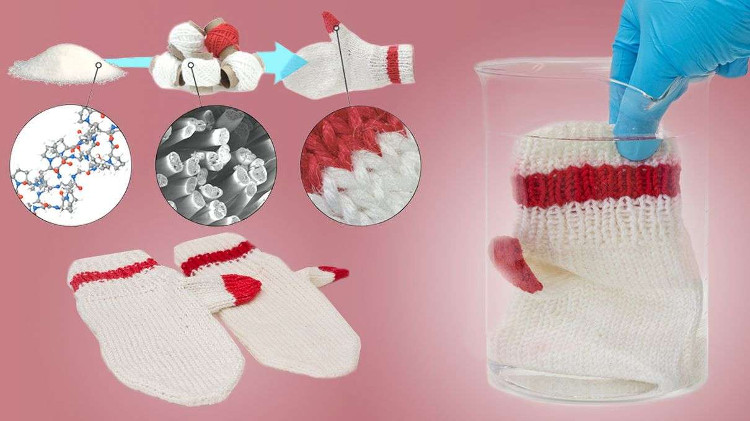Fabrication of fabric fibers from animal skin and bones? How?
It doesn't sound like high fashion but "yarn from slaughterhouses", the common name for fibers made from agricultural by-products such as gelatin, keratin and casein , may soon create a trend. pages from discarded things like skin, bones, tendons . animals.
Textile products made from animal by-products are thought to be high-end equivalent to those made from cashmere and yarns are only compared to merino wool. If practical, this will help reduce the amount of livestock waste, reduce pollution from the production of synthetic fabrics such as polyester and nylon, materials of course origin. fossil fuels

How to make fabric fibers from animal by-products.
Philipp R. Stoessel, a graduate student at the Functional Materials Laboratory (FML) by Professor Wendelin J. Stark, in Zurich, Switzerland, successfully transformed bio-waste into a basic component fiber is gelatin , according to a recently published article by Biomacromolecules magazine.
Yes, we're talking about gelatin, the biological material made of collagen in the skin, bones and tendons of cows, sheep and pigs. This is also the main ingredient in Jell-O since 1897 (and other desserts), now made into yarn, thanks to the Stoessel. The invention by him and the FML team collaborated with the Advanced Fibers laboratory at EMPA (Institute of Materials Science and Technology) in Dubendorf, Switzerland.
From meat to gloves
During the experiment, the group discovered when an organic solvent, in this case isopropyl , was added to a hot solution of deionized water and gelatin in pork (a solution of gel containing water) protein will have an interesting reaction: precipitate and settle to the bottom of the cup. Using a pipette can pull this mixture into a long, thin thread.
To begin making fibers, they took gelatin from the bottom of the container, then used a jet nozzle to squeeze into separate strands on a Teflon-coated coil wrapped in ethanol solution, which prevents the fibers from sticking. each other and harden gelatin.
With a dedicated spinning machine, the researchers produced up to 200 meters of yarn every 60 seconds. If made by hand, they roll up to 1,000 threads of half the thickness of a hair into a thread. After that, you're just weaving.
According to the researchers, there is a visual and tactile difference between wool and gelatin fibers. While wool feels itchy and rough to the touch, a pair of gloves is woven with gelatin fiber to give it a soft, glossy feel that is not on wool gloves.

Ultra-thin fibers made from biological materials are pressed with ethanol-soaked coils.
One drawback of "abattoir fibers " : Gelatin fibers are usually water soluble, an unexpected property if used for clothing. To achieve wool-like water resistance, the team treated epoxy resin fibers, then continued to use formaldehyde to increase durability and firmness, while reducing absorption. They also use lanolin (a kind of sheep fat) to soften the fiber. The Stoessel is planning further studies to increase the water resistance of the gelatin fiber until the end of its doctoral program.
Different reactions
Suzanna Bibens, a nurse, mother of four and a lover of knitting wool and cotton fibers, said: "I think this is a great idea. Reduce waste, including animal waste. In fact, I may need to feel and smell the thread or thread to decide whether or not to buy. "
However, Nancie Meng, a long-time needleworker and grandmother of three grandchildren, thinks it should not be.
"Waste, it sounds horrible," Meng said.
The Stoessel and his colleagues Robert N. Grass and Wendelin Jan Stark were recognized as inventors of the invention of spin and press processing, producing separate gelatin fibers after the patent was submitted. submit in 2014.
- Waterproof fabric thanks to its ability to drain water
- How is wool 'turned' into fabric?
- Russia found materials for producing 'super-armor' armor for firefighters
- 'Planting' skin from collagen: The industry's laudable environmental protection effort
- What are the dangers of fabric dyeing water?
- Production of ink-inspired camouflage material
- 10 animals have extremely special skin
- Why after a shower in the winter or itching?
- Intelligent fabric can detect and protect against harmful gases
- The weather is hot, what kind of fabric is best for hot sun protection?
- Technology time, even fabric can be woven from fiber, led
- Strange fabrics themselves 'react quickly' to dangers
 'Fine laughs' - Scary and painful torture in ancient times
'Fine laughs' - Scary and painful torture in ancient times The sequence of numbers 142857 of the Egyptian pyramids is known as the strangest number in the world - Why?
The sequence of numbers 142857 of the Egyptian pyramids is known as the strangest number in the world - Why? History of the iron
History of the iron What is alum?
What is alum?